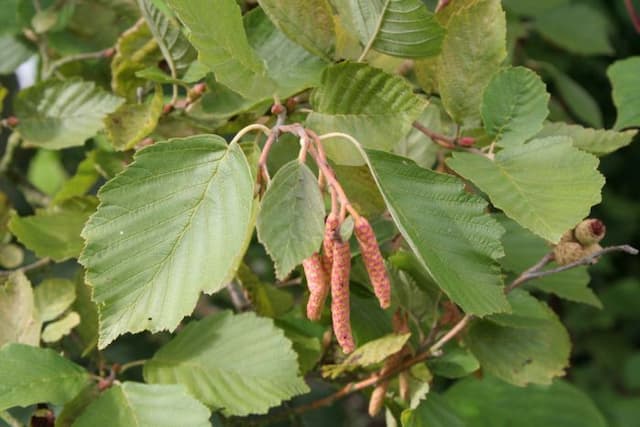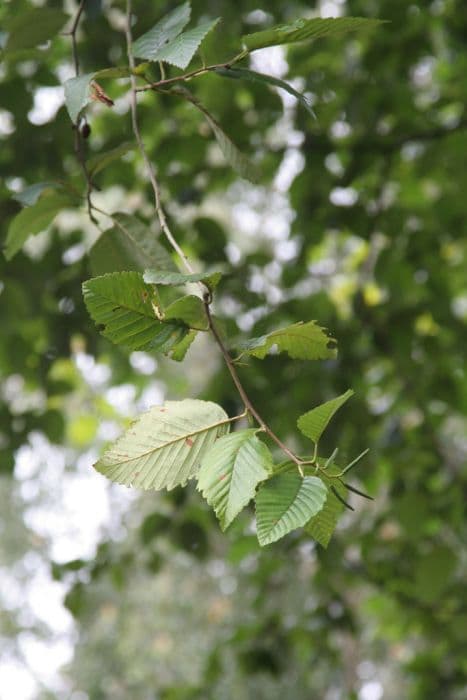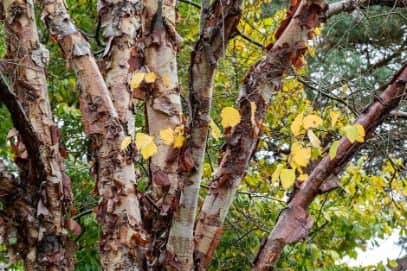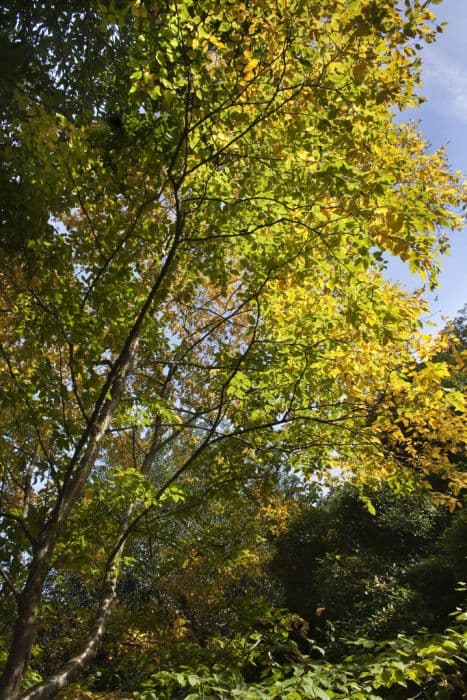Betula pendula subsp. pendula 'Spider Alley' (PBR)

ABOUT
The 'Spider Alley' is a unique variety of silver birch tree recognized for its distinct visual qualities. It has a graceful, elegant appearance with an attractive, slender trunk, which typically showcases a silvery-white bark that peels and flakes to provide a captivating texture and visual interest to the landscape. The branches are somewhat pendulous, creating a weeping effect that enhances the tree's delicate beauty. During the spring, this tree blooms with small, inconspicuous flowers which are called catkins. These yellow-brown catkins hang from the branches, adding a subtle charm to the tree as they sway in the breeze. Later in the year, the leaves of the Spider Alley emerge. These leaves are typically diamond-shaped with serrated edges and a lush green color that shimmers in the sunlight. The foliage often turns to bright yellow hues, providing a striking contrast against the silver bark in the fall, before dropping as the cold of winter approaches. Overall, 'Spider Alley' is admired for its ornamental bark, elegant form and the seasonal changes it exhibits throughout the year, from the budding leaves of spring to the vivid autumn colors. It provides visual interest in gardens and landscapes, regardless of the season.
About this plant
 Names
NamesSynonyms
European White Birch, Silver Birch, Weeping Birch.
Common names
Betula pendula subsp. pendula 'Spider Alley' (PBR)
 Toxicity
ToxicityTo humans
European White Birch, which Betula pendula is commonly known as, is generally considered non-toxic to humans. There are no significant reports of poisoning or toxic reactions from ingesting parts of this plant, such as the leaves or bark. However, as with any plant, individual allergies or sensitivities can occur, and it is generally not advisable to consume plant parts without certainty of their safety.
To pets
European White Birch, which Betula pendula is commonly known as, is not known to be toxic to pets such as cats and dogs. Ingesting parts of the birch tree typically does not cause poisoning or serious health issues in pets. Nevertheless, the eating of non-food items by animals can sometimes lead to gastrointestinal upset or blockages, so it is still wise to prevent pets from consuming large amounts of plant material.
 Characteristics
CharacteristicsLife cycle
Perennials
Foliage type
Deciduous
Color of leaves
Green
Height
20 feet (6 meters)
Spread
15 feet (4.5 meters)
Plant type
Tree
Hardiness zones
3
Native area
Europe Asia
Benefits
 General Benefits
General Benefits- Ornamental Appeal: The Silver Birch 'Spider Alley' has a unique and attractive appearance with its slender branches and delicate foliage, making it an eye-catching addition to landscapes.
- Shade Provider: Due to its canopy structure, this birch tree offers shade in gardens and parks, creating a cool, comfortable environment beneath its branches.
- Habitat for Wildlife: The Silver Birch 'Spider Alley' can provide a habitat for various species of birds and insects, contributing to local biodiversity.
- Seasonal Interest: It displays a seasonal transformation with distinct characteristics, such as vibrant green leaves in spring and summer, and striking yellow fall color.
- Soil Improvement: Like many birches, this subspecies can improve soil quality through leaf litter that decomposes and adds nutrients to the earth.
- Drought Tolerance: Once established, it is relatively tolerant of dry conditions, making it suitable for a range of environments and reducing the need for frequent watering.
 Medical Properties
Medical PropertiesThis plant is not used for medical purposes.
 Air-purifying Qualities
Air-purifying QualitiesThis plant is not specifically known for air purifying qualities.
 Other Uses
Other Uses- Woodworking: Silver birch wood can be used for intricate woodworking projects, including carving and turning on a lathe, due to its fine grain and even texture.
- Educational Resources: Tapping silver birch trees can be an educational activity to teach students about sap extraction and photosynthesis processes.
- Landscape Design: Silver birch can be planted in groves or alleys to create dramatic linear landscape features, particularly in large public gardens or parks.
- Photography: Its unique bark and slender branches make the silver birch a favorite subject for nature photographers, especially in winter when the tree's silhouette is most striking.
- Wildlife Shelter: Intentionally leaving dead or dying silver birch trees in a wooded area can provide nesting sites and habitats for various bird species and insects.
- Sound Dampening: When planted in mass, silver birch can help reduce noise pollution as the dense foliage can absorb and scatter sound waves.
- Soil Improvement: Fallen leaves from silver birch can be collected and composted to create a leaf mould, enriching garden soils with nutrients and improving soil structure.
- Cultural Symbolism: Incorporating silver birch into art and cultural festivals as a symbol of renewal and purification, drawing on various cultural significances attributed to the tree.
- Dye Production: Bark and leaves of silver birch can be used to produce natural dyes for textiles, yielding colors ranging from beige to light green.
- Culinary Experiments: While not widely recognized, the sap of the silver birch can be used in the fermentation of homemade wines and beer, adding a delicate sweet flavor.
Interesting Facts
 Feng Shui
Feng ShuiThe Silver Birch is not used in Feng Shui practice.
 Zodiac Sign Compitability
Zodiac Sign CompitabilityThe Silver Birch is not used in astrology practice.
 Plant Symbolism
Plant Symbolism- Purity: Due to its distinctive white bark and graceful appearance, the European White Birch, which 'Spider Alley' is a variety of, often symbolizes purity and innocence.
- New beginnings: This tree tends to be one of the first plants to grow back after a forest has been cleared or burned, so it represents new beginnings and rebirth.
- Hope: With its light and airy canopy, the European White Birch provides a sense of hope and optimism, suggesting the lightness of being and an uplifting perspective.
- Protection: In various cultures, the Birch tree is thought to protect those nearby by warding off evil and negativity, perhaps related to the tree's capacity to pioneer new growth in barren landscapes.
- Love: Sometimes, the Birch is associated with love and fertility, likely due to its prolific seed production and the heart-shaped leaves of some birch species.
- Adaptability: Able to thrive in diverse environments, the Birch symbolizes adaptability and the ability to flourish in various conditions.
 Water
WaterThe most common common name of Betula pendula subsp. pendula 'Spider Alley' (PBR) is the Silver Birch. For young Silver Birch trees, water them with about 2 gallons per week during the first growing season. Mature trees are quite drought-resistant, but during prolonged dry spells without rain, they benefit from an occasional deep watering, where you might provide 10-15 gallons every two to three weeks. In general, it's best to water the tree slowly, allowing moisture to penetrate deeply into the soil, encouraging deep root growth. Avoid frequent shallow watering as this can lead to weak root systems.
 Light
LightSilver Birch trees prefer full sun to partial shade. They thrive in locations where they can receive at least 6 hours of direct sunlight daily. The best spot for a Silver Birch would be an open area where sunlight is abundant, which helps ensure healthy growth and good foliage density.
 Temperature
TemperatureSilver Birch trees are hardy and can tolerate a wide range of temperatures, generally thriving in zones typically encompassing 35°F to 75°F. However, it's important that the Silver Birch does not remain in temperatures over 80°F for prolonged periods. These trees can survive winter conditions down to -40°F. The ideal growing conditions would be an area where average temperatures range between 50°F and 70°F.
 Pruning
PruningSilver Birch trees should be pruned to maintain their shape and remove any damaged or diseased branches. The best time for pruning is late winter to early spring before new growth starts, as this minimizes sap loss. Light pruning can be done annually, while more extensive shaping should be done less frequently. Always use clean, sharp tools to make clean cuts.
 Cleaning
CleaningAs needed
 Soil
SoilSilver birch requires well-draining soil with a pH range of 5.5 to 7.5. A mix of loam, sand, and peat is ideal to ensure proper drainage and aeration. Regular organic matter enrichment will improve soil structure and nutrient availability.
 Repotting
RepottingAs a large, fast-growing tree, silver birch does not typically require repotting. It's best planted directly in the ground and given sufficient space to grow without constraints.
 Humidity & Misting
Humidity & MistingSilver birch thrives in average humidity levels found in temperate climates; it does not have specific humidity requirements and can adapt to local atmospheric conditions.
 Suitable locations
Suitable locationsIndoor
Not suited for indoor growing; needs outdoor environment.
Outdoor
Plant in well-draining soil, full sun to partial shade.
Hardiness zone
2-7 USDA.
 Life cycle
Life cycleSilver birch 'Spider Alley' begins its life cycle with seed germination typically in the spring, following dispersal by wind due to the lightweight nature of its winged seeds. Upon germination, the seedling emerges and starts the vegetative growth phase, which involves developing a root system and shoots. As the plant matures, it enters the sapling stage, characterized by rapid vertical growth and the beginning of bark development. Once reaching maturity, 'Spider Alley' produces catkins; the male catkins release pollen, which fertilizes the female catkins, leading to the development of new seeds. During its reproductive phase, which can last for many decades, the tree goes through annual cycles of dormancy in winter and active growth in spring and summer. As it ages, the tree eventually enters senescence, where growth slows and it becomes more susceptible to environmental stresses and diseases, leading to its eventual death.
 Propogation
PropogationPropogation time
Spring-Early Summer
Propogation: The most popular method of propagation for the Silver Birch 'Spider Alley' is through seed collection and sowing. Propagation via seeds typically occurs in late fall after the seeds have matured. One must collect the catkins, which contain the tiny seeds, and extract the seeds by gently crushing the catkins. The seeds should be surface sown as they require light for germination. Before sowing, a period of cold stratification for about four to six weeks is beneficial to break seed dormancy. The stratified seeds can then be sown in well-drained soil under bright conditions. Germination may take a few weeks, after which the seedlings can be cultivated further until they are strong enough to be planted in their permanent locations.









